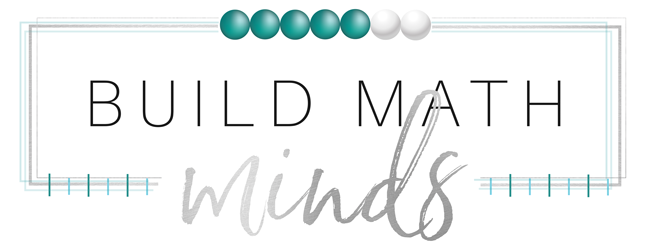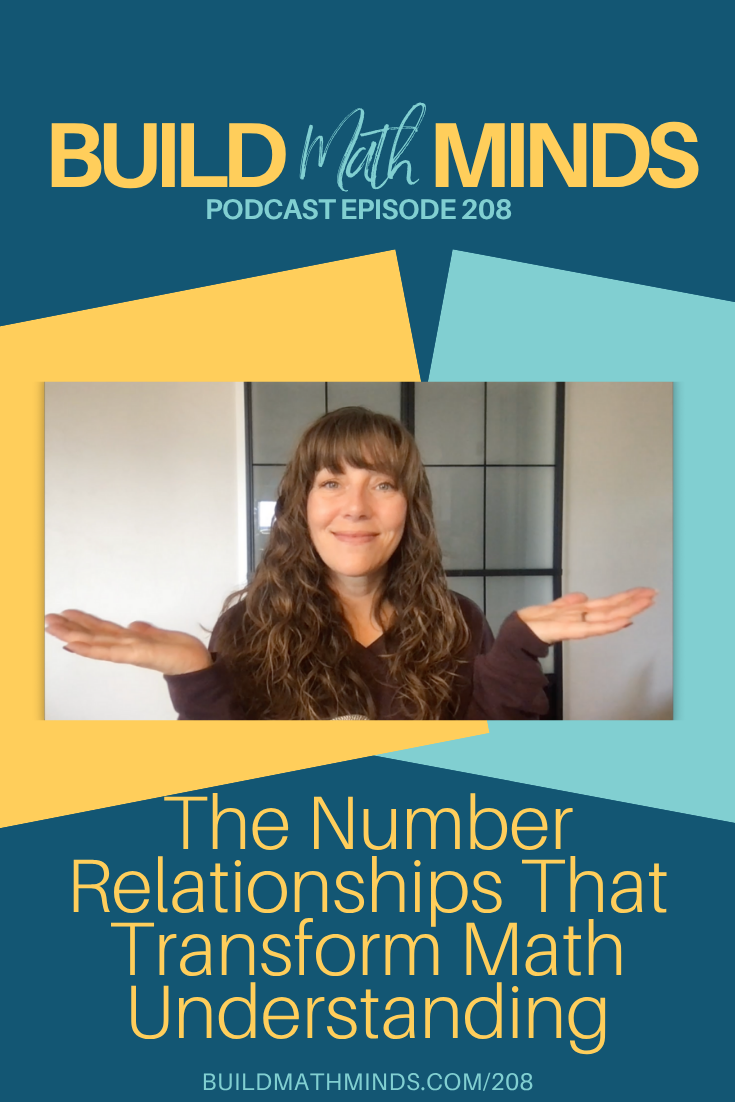Episode 1 in the Building Math Fluency Series
Request access to the PreK-2 Free Resources (including the Number Relationships Assessment)
Request access to the 3rd-5th Free Resources (including the Number Relationships Assessment)
1% Better Math Activities episode
Teaching Student Centered Mathematics PreK-2 from John Van de Walle, et al.
Teaching Student Centered Mathematics 3rd-5th from John Van de Walle, et al.
Welcome fellow Recovering Traditionalists to Episode 208: The Number Relationships That Transform Math Understanding
Welcome to episode 2 of my series on building math fluency in elementary students. I’m sharing some of the foundational concepts that actually build students’ mathematical understanding, not just their ability to follow procedures.
The first episode was all about the 4 early numeracy concepts all students need around all types of numbers (yes even fractions and decimals) but most of them centered around counting, yet one of the biggest complaints I hear is that you can’t get students to stop counting. This episode is about helping your students stop counting, however I want to make sure you know that counting, and counting on fingers, is an important foundation. Kids need the time and experience with counting on their fingers. However, we don’t want them to stay there.
We don’t want 3rd graders counting on their fingers to solve 7 + 8. We don’t want 6th graders counting one-by-one to solve multiplication problems. When they first start learning a concept they will count, but if they haven’t progressed past that they are most likely missing some key number sense foundations. And once you know what those foundations are, you can finally help them break free.
These relationships are the secret sauce that makes everything else in math make sense. They show students how numbers connect to each other. They’re what allow students to think flexibly, to see patterns, and to actually develop math strategies in a way that makes sense instead of just following the steps mindlessly.
We were taught to help students memorize facts, but we weren’t taught to help them understand the relationships between numbers. We just taught that 8+5=13, we didn’t really think about how 8+5 is also 8+2+3. But if you were anything like me, when this focus on different strategies started, I just taught the steps for the strategies and had kids basically memorize the steps. Doing that just led to more and more things students had to memorize. Instead, when we start focusing on number relationships, everything changes for students. These relationships come from the book Teaching Student Centered Mathematics from John Van de Walle, et al.
The Four Number Relationships Overview
The four number relationships are: spatial relationships, one/two more or less, benchmarks of 5 and 10, and part-part-whole. These might sound simple, but they’re incredibly powerful. And just like the foundations, these relationships develop in sophistication from PreK all the way through fifth grade.
Let’s take a quick look at each one.
Relationship #1: SPATIAL RELATIONSHIPS
Spatial relationships are about seeing numbers in arrangements and patterns AND using those to build relationships between quantities. This builds directly on subitizing, but goes deeper.
In kindergarten and first grade, spatial relationships help students recognize that 5 dots in a line and 5 dots in a circle pattern are both 5 and those visuals help them see how 5 is connected to 4, 6, 7, really any number.
As they progress, students should be using spatial relationships to understand place value. They should see that 23 is 2 groups of ten and 3 ones and how that can transform into 1 ten and 13 ones. They should visualize 23 on a number line between 20 and 30 and be able to tell you where it is in relation to 25.
In upper elementary, spatial relationships become crucial for understanding fractions and area. When students look at a fraction model, can they see the relationship between the parts and the whole? Do they see how that fraction relates to other fractions?
Students with strong spatial relationships don’t need to draw out every single unit to understand a problem. They can visualize and use those mental images to solve problems efficiently.
Relationship #2: ONE/TWO MORE OR LESS
The second relationship is understanding one and two more or less. This is tied directly to counting yet lots of kids don’t see that. They’ve been counting and saying the sequences of numbers but this idea helps them tie those counts to adding more and subtracting out some to make it less. The first place to start with that is adding/subtracting one or two.
In early grades, this is pretty straightforward. Students learn that 7 is one more than 6 and one less than 8.
Then this relationship starts to build to units, where kids start to think about 1 TEN more or 2 TENS less. Two HUNDREDS more, one HUNDRED less.
In upper elementary, this relationship needs developed with fractions and decimals. Do they know what is 1 TENTH less? Can they look at 5/8 and know it’s one more eighth away from 6/8 or 3/4.
Here’s the problem we see all the time: when students don’t have this relationship, it makes strategy development so much harder. When they see 23+29 they will just line up the numbers and add each digit, even when they could just think “23+30=53, minus 1 is 52.” They’re doing more work than necessary because they can’t see this relationship.
Relationship #3: BENCHMARKS OF 5 AND 10
This brings us to the third relationship of using benchmarks of 5 and 10. Which really is just Benchmarks because it does start out as 5 & 10 but transforms to all kinds of benchmark numbers. There are all kinds of friendly numbers students could be using as reference points.
In early elementary, students do need to learn to see numbers in relation to 5 and 10. They see 7 as “5 and 2 more” or 8 as “2 away from 10.” This makes adding and subtracting so much easier. Instead of counting by ones, they can use these benchmarks because any number is always 3 or less away from a benchmark number.
This relationship gets more sophisticated as students get older. They use 5 and 10 as benchmarks when multiplying, because knowing what 10 groups of 8 is can help you with 9 groups of 8. They use multiples of 10 as benchmarks when adding and subtracting, like when solving 38+25 as “40+25, minus 2.”
In upper elementary, students should be using benchmark fractions. They should know that 3/8 is less than 1/2, that 7/8 is close to 1, and that 1 3/4 is close to 2. These benchmarks help making adding & subtracting fractions so much easier.
Without understanding how numbers relate to benchmarks, students will never be able to understand strategies you are trying to teach them.
Relationship #4: PART-PART-WHOLE
The fourth relationship is part-part-whole—understanding that numbers can be broken apart and recombined in different ways.
This is such an essential relationship for developing flexibility with numbers. In the early grades, students learn that 8 can be 5+3, 4+4, 6+2, or 7+1. They learn that you can decompose numbers in different ways depending on what’s helpful for the problem.
In the upper grades, students start to use part-part-whole thinking with larger numbers and multiplication. They should see that 25×4 could be broken into (20×4)+(5×4). They should be breaking apart numbers strategically to make calculations easier.
Part-part-whole thinking is also needed fractions. Students need to understand that 3/4 is composed of three 1/4 pieces, which could be combined as 2/4 and ¼ which is 1/2 + ¼.
This part-part-whole thinking helps students see an easier problem within a harder problem. Too often we see students who know 5+5 but they don’t understand that when they have 6+5, it contains 5+5 within it. Or they can multiply 25×4 and get 100, but when asked to multiply 25×8, they have no idea. They can’t see that 25×8 is just double 25×4. They’re missing that part-part-whole relationship.
Why These Relationships Matter
Here’s what happens when students have these four relationships: they become flexible thinkers. They don’t just have one way to solve a problem—they have multiple strategies they can choose from depending on the numbers involved.
They can look at 8+5 and think, “I’ll take 2 from the 5 and make 10+3.” They can look at 4 ⅜ +3 ¾ and think, “3 ¾ is just ¼ away from 4, so I’m going to take 2/8 from the 4 ⅜ to make 4 and now I have 4 ⅛ + 4.” They can estimate, check their work, and know if an answer makes sense.
Without these relationships, students are stuck following procedures without understanding. They might get correct answers, but they can’t explain anything beyond just the steps they took to solve it, they can’t adapt when numbers change, and they often struggle with word problems because they don’t understand the relationships between the quantities.
PRACTICAL TAKEAWAY
So here’s your task for this week: As you’re teaching, start asking questions that reveal these relationships.
Don’t just ask, “What’s the answer?” Ask, “How did you see it? How does ___ relate to ____? Could you solve it in a different way?”
When a student says just an answer, ask them, “How did you think about it?” or “If someone in class didn’t instantly know the answer, how would you help them figure it out?”
These questions help you see what relationships your students have and which ones they need to develop. And the more you ask these questions, the more your students will start thinking in terms of relationships instead of just procedures.
If you want help with specific questions or tasks to give your students that help you dig in to see what number relationships they have and which ones they are still working on, I’ve got a free number sense assessment. The assessment is part of my Number Sense e-book and there is one for PreK-2 and 3-5. The PDF gives you an overview of each of these 4 number relationships and tasks/questions you can ask students to see how they are progressing in their development of each of the relationships.
Head to the show notes page which is BuildMathMinds.com/208 and there will be a link to request access to the PreK-2 and the 3-5. The access you get is not just for the Number Sense e-book, it gives you access to a bunch of free resources I have for each of those grade bands. So once you get emailed the link to the website, just look for the “Overview of Number Relationships and Assessments” document.
Then once you’ve done some of the tasks and know which relationships your students will need a little more help developing, I’ve got a great activity you can do to help build those relationships, but that’s coming in the next episode.
Thanks for joining me for episode two! We’ve now covered all eight number sense concepts—four foundations and four relationships. And as I said, in the next episode, I’m going to show you one of my favorite practical tools for building all of these concepts. In a past episode I talked about making math experiences for students 1% better by changing just 5 minutes of your math time. In our next episode I’m sharing my favorite 5 minute activity and how it helps you build these foundational number sense concepts. Don’t forget to go to BuildMathMinds.com/208 to get the resources and I’ll link up the 1% Better Math Activities in case you missed that episode.
Until next week, my fellow Recovering Traditionalists, keep letting your students explore math, keep questioning, and most importantly, keep Building Math Minds.




